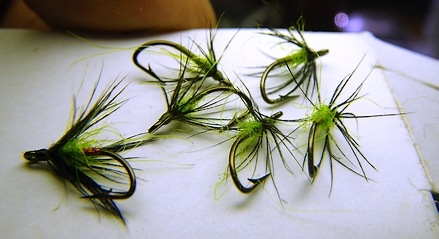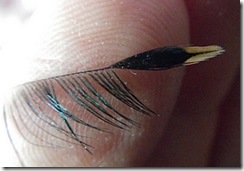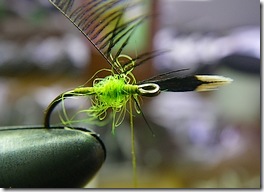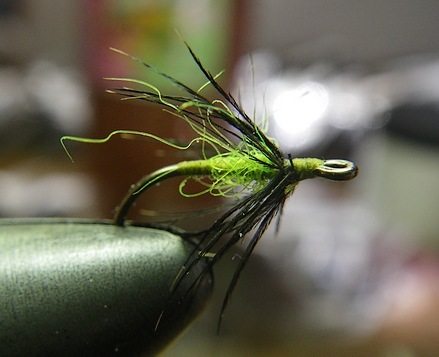With a bit of sun poking through the weather, I’m reminded that fish exist and I’ve got holes aplenty in my fly box from last season. This time it’s the flymphs that took a beating – and it being the self pronounced Second Coming of the Attractors, I’m restocking not the dull and drab – but all the colorful patterns I hid from prying eyes while telling the crowd it was something I’d made from ocher sock yarn …
… which reminded me further of the hellish time I had learning how to reduce a dressing down to just enough to be ate consistently, but not smothering the pattern with too much material.

The lower left fly is tied with an intact Starling hackle, while the rest of the flies are tied with one side of the feather removed. Four or five strands of starling will give plenty of motion, more just dampens the wiggle as a neighboring strand blocks movement.

Starling feathers being under two inches long and quite fragile, you’ll need to prepare the feather by removing all the gray fibers off both sides of the stem, before carefully removing all of the right side fibers (if wrapping clockwise, left side if counter-clock) and tying in the feather where the hackle is to be wound.

As we only have one side fibered, two turns is just enough to apply a single turn of hackle, perhaps five to seven strands.
The reduced dressings look simple, but often have subtleties that reveal themselves when you’ve got a handful of gossamer and are only partway through a mighty oath.
Both body and head use a bit more fancy threadwork than meets the eye. The bobbin is spun so the thread ties flat like a floss rather than round like thread. Us old guys set store by this quality in the Nymo days of the 70’s, and it still works with 6/0 and 8/0 threads that are not unifilament style. Simply let the bobbin dangle and it will spin flat to remove all twist you’ve added via previous turns. Once it stops spinning the thread will lay flat like floss, until you add more torque by wrapping. Flat thread has less bulk than round thread, so it spreads itself onto the hook like a film versus a tightly wound single strand of material.
It’s a nice effect, the body is uncommon smooth and the head is small and dainty.

This is a Redditch scale #12 heavy wire hook. That would be a #14 in today’s longer shank hooks. The heavy wire adds enough weight to drag the reduced dressing down to fish in mid column – great for emerging bugs and pre-hatch feeding.

Thanks Keith.
Since you don’t send me flies, how-to posts are the next best thing.
Even better actually, and very much appreciated.
Panfish would love these.
Gott agree with Don, as a relative newcomer to fly tying I have found your how-to posts very helpful over the last couple of years. I have especially learned a lot about using non-traditional materials.
These remind me of North Country Spiders. I saw an Oliver Edwards Video where he touts them and mentioned “The practical angler, or The art of trout-fishing” by W.C. Stewart. It piqued my interest about the book. It was written around 1850 and if you want to peruse it you can find it on google books.
I’m sure Stewart would grab a handful of these.
As always, great looking flies.
Algae emerger?
Congrats on scoring heavy ring-eye sproats. You may have already given us the details on the hooks but a recap wouldn’t hurt.
It was the greatest hook deal of this century, 500 for $1.00
http://singlebarbed.com/2010/05/27/ancient-iron-revisited/
http://singlebarbed.com/2010/04/15/where-we-stumble-across-the-good-old-days-and-buy-a-couple-of-armloads-of-the-stuff/
These were the Mustad 4707, heavy wire, limerick bend, ring eye … nice for wet flies and nymphs both.
You’ve proven that being obsessive/compulsive occasionally pays off big.
The steely fruits of Oslo lay before you.
Love a good starling soft hackle. I love them as dropper off a bushy dry fly for Smoky Mountain stream brookies.
This rings a wonderfully perfect note with me as well. Drifted down and across behind a Wulff, or a Stimmy. And, the question is always, “Which will be the take?”.
Thanks for another inspiring tie.
you have a nice touch!
i only get out for trout once or twice a year
but the green and black has taken lots of bass and crappie.
the sparser tie on a heavy hook sinks nicely and refrains from the boisterous splashing of its beadhead cousins.
now try it in orange with a mallard flank hackle.
an amazing carp fly.
browns seem to enjoy the pattern as well.
I’ll take you up on the Mallard flank – Orange variant, it’s hard not to pick a color scheme that doesn’t look downright tasty – and I can always use more killer carp flies.
Nice flies tied on a ‘proper’ hook and look at that long point and big sexy barb. You don’t see real hooks made like this anymore, nowadays it’s micro-barb this and chemically sharpened that. If I want a sharp hook I’ll sharpen it myself with a file and put any type of point on it. After 46 years of using the full gamut of hook styles for salmon, trout and sea trout flies I have come to the conclusion that a ring eyed, non forged limerick hook pattern with a decent barb and not too sharp a point is the best fish holding design. The ring eye combined with a loop knot gives the best true movement through the water and the limerick bend provides a focal point to hold onto the fish. Again, sexy flies!